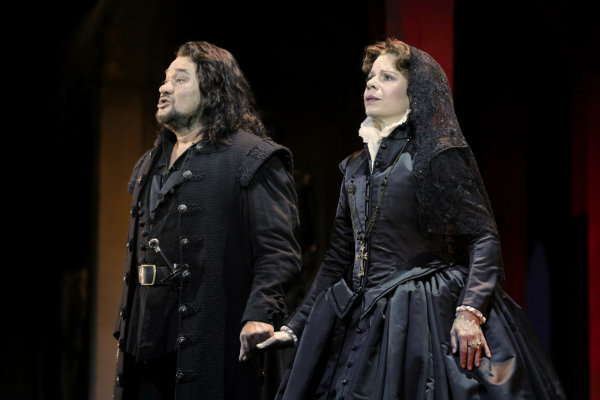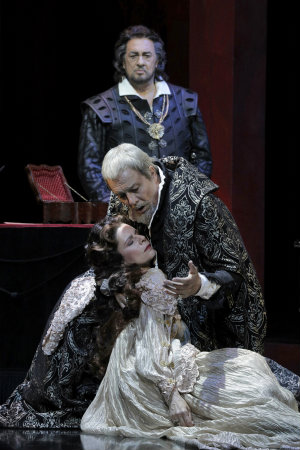Opera Review: ‘Don Carlo,’ Los Angeles Opera
Oct. 2, 2018

Ramon Vargas as Don Carlo and Ana Maria Martinez as Elisabeth de Valois in LA Opera’s 2018 production of “Don Carlo.” (Photo: Cory Weaver / LA Opera)
GIUSEPPE VERDI
DON CARLO
LOS ANGELES OPERA
SEPTEMBER 29, 2018
By Carol Jean Delmar
Opera Theater Ink
Original in Beverly Hills Courier at BHCourier.com
I really wanted to write a review of LA Opera’s current production of Giuseppe Verdi’s “Don Carlo” even though I am in the midst of moving from Beverlywood to Hidden Hills. But I guess it wasn’t meant to be.
I have been seeing signs adorn the streets near Beverly Hills and around Los Angeles
which brand tenor Plácido Domingo as the star of “Don Carlo.” He may be, but then so
may also be Ramón Vargas as Don Carlo, Ana María Martínez as Elisabeth de Valois,
Anna Smirnova as Princess Eboli, and the magnificent Ferruccio Furlanetto as King
Philip II. Each singer has the ability to shine or be forgotten, to be a team member or a standout star. The two main roles and stars are usually Don Carlo and Elisabeth with King Philip close behind, and the other roles are secondary. But because Verdi wrote a score with exquisite arias for all, secondary roles can reach to new heights, and primary roles can fall by the way side. One thing is certain: Domingo is a draw, and he’s the general director of LA Opera.
I saw this production of “Don Carlo” twice in 2006, and had a ticket for Sept. 29 at the Dorothy Chandler Pavilion. I just love the music.
But as I said, I guess this review wasn’t in the cards. I have not been well, and I got all dressed up to drive downtown to hear this opera, but when I got into the garage, no one would help me find a spot to park, and I was there almost an hour early. I was directed to go to the fourth level where the disabled parking is, but no one there would help me. After trying and trying to find a spot, I finally gave up and left the parking lot and went to the valet parking area where the cars were lined up like canned sardines. So I drove onto the freeway and got lost since I had also lost my sense of direction. Then a young woman finally oriented me back toward Beverly Hills after I turned into a gas station and honked for help.
I made it home a bit frazzled, but I still really wanted to get my views out about the word, “star,” and what it means to star in “Don Carlo.” I also wanted to write about the role of Rodrigo, Marquis of Posa, and the type of singer I believe Posa should be. So I am still going to write some of my thoughts here, and I hope you will go to the opera and decide for yourselves.
Based on Friedrich von Schiller’s play of the same name, the action in “Don Carlo” takes place in Spain in the sixteenth century at the time of the Spanish Inquisition. The political climate between France and Spain is such that Elisabeth marries King Philip II instead of her true love, Don Carlo, his son. Carlo’s friend, Rodrigo, Marquis of Posa, entreats Carlo to go to the Netherlands to help restore religious freedoms for the Flemish, then oppressed by Spanish rule. Catholics vs. Protestants — Carlo goes against his father’s ideals to fight for the Protestants in Flanders. Posa dies for his friend Carlo, and Carlo continues to embark on his friend’s mission.
Domingo, a great tenor with ringing high notes, no longer has the high notes. Of course, the audience never hears them since rather than sing tenor roles at the age of 77, Domingo has chosen to continue in the grand profession he loves and has mastered, by both conducting and singing roles with lower tessituras. In some roles, baritones can be lyric baritones with voices that almost mimic tenors, while in other parts, they should have voices that can be chocolaty, rich and full, and almost have the sound of a bass-baritone in quality. Posa is just such a role. What makes “Don Carlo” such a melodic opera is that the timbres of the various voices blend to create beauty that surpasses the sounds inherent in many other operas. So although Domingo is able to sing some baritonal roles well, in this particular opera — even though he always sings with zest, vigor, youthfulness, and a flawless sound and technique — he still has the ring of a tenor, and nothing can make his Posa have the rich, sonorous quality that is usually required of the Verdi baritone. Yet, a novice to opera, not a true opera buff, can be very satisfied with Domingo as Posa since he sings with, as said before, flawless technique, ringing tones,and an acting ability rarely equaled by other tenors or baritones. Domingo is a force of nature although his age is evident in his voice and demeanor. I personally would rather
hear a tenor as Posa who has great vocal technique and acting ability than a baritonal Posa who has neither. But the ideal is to hear a Verdi baritone as Posa who can win the audience over with his characterization and voice.
Bass Ferruccio Furlanetto is the perfect Philip II. As the Philip of choice throughout the world, Furlanetto sang the role in LA Opera’s 2006 production. His “Ella giammai m’amò” is seasoned and exquisite — beginning with deep introspection, then blooming into agonizing passion as he comes to the realization that he will never win the queen’s heart. Furlanetto inhabits the role. His voice is rich and deep. Every stare and hand gesture, although subtle, adds to the intensity of emotions Furlanetto is able to communicate. Furlanetto is truly a star.
Ramón Vargas’s arias and duets with Elisabeth and Posa support the fact that he should be the star of the opera that bears his character’s name, but other singers have the ability to take center stage.
Soprano Ana María Martínez is no stranger to LA Opera audiences. Her flexibility
enables her to sing numerous roles well, whether lyric or spinto. And finally, Anna
Smirnova’s Princess Eboli enables her to glide through arias like the “Veil Song” and a dynamic “O don fatale.”
Morris Robinson’s Grand Inquisitor and Soloman Howard’s Monk make the lower sounds
prevail. If you love the low voice timbre, this is the opera for you.
Ian Judge’s production has one basic set, with arches moving and rolling in and out on casters, designed by John Gunter. Various hues of light draw attention to the singers, and Tim Goodchild’s gorgeous period costumes add to the vision. Supernumeraries and a grand chorus led by Grant Gershon create a magnificent spectacle in the square when the heretics are condemned by the Inquisition. The scene was spectacular in 2006.
Conductor James Conlon always leads the LA Opera orchestra with bravura. He knows
how to make the orchestra shine with big sound when indicated and how to follow the
singers when desired, without overshadowing or drowning them out.
“Don Carlo” is an opera for stars, and LA Opera’s current production of “Don Carlo” has many.
Conductor: James Conlon
Production: Ian Judge
Stage Director: Louisa Muller
Set Design: John Gunter
Costume Design: Tim Goodchild
Lighting Design: Rick Fisher
Chorus Master: Grant Gershon
Choreographer: Kitty McNamee
Alexander Vinogradov sings Philip from Oct. 4 to 14. Performances continue Thursdays, Oct. 4 and 11, at 7:30 pm and Sundays, Oct. 7 and 14, at 2 pm.
Carol Jean Delmar is the author of “Serenade: A Memoir of Music and Love from Vienna
and Prague to Los Angeles, 1927 to World War II to 2012.” She writes opera and theater reviews for the BH Courier and operatheaterink.com, and currently lives in Beverlywood.

Ana María Martínez as Elisabeth de Valois, Ferruccio Furlanetto as King Philip II and Plácido Domingo as Rodrigo in LA Opera’s 2018 production of “Don Carlo.” (photo: Cory Weaver)